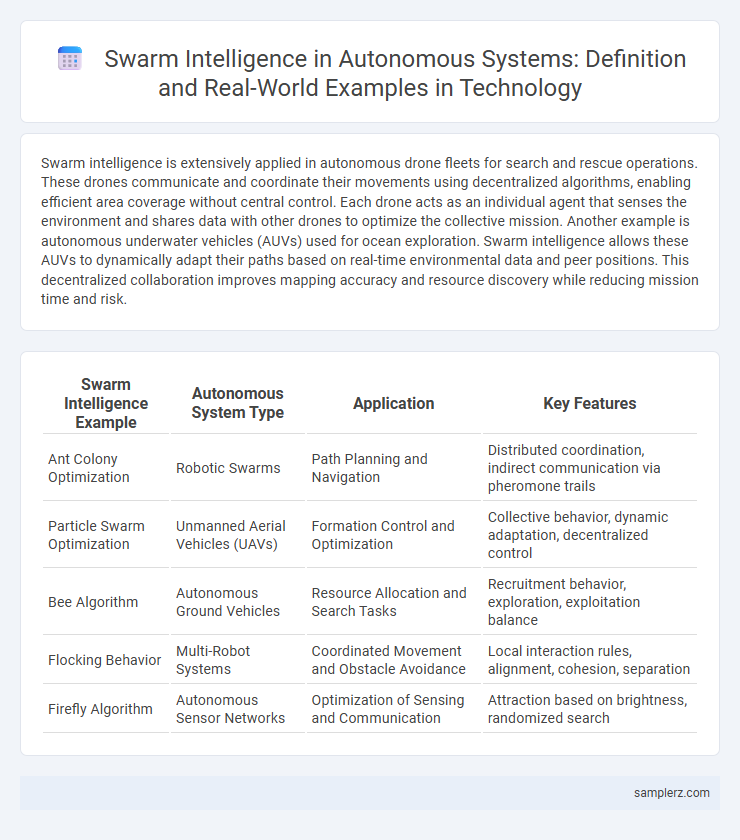Swarm intelligence is extensively applied in autonomous drone fleets for search and rescue operations. These drones communicate and coordinate their movements using decentralized algorithms, enabling efficient area coverage without central control. Each drone acts as an individual agent that senses the environment and shares data with other drones to optimize the collective mission. Another example is autonomous underwater vehicles (AUVs) used for ocean exploration. Swarm intelligence allows these AUVs to dynamically adapt their paths based on real-time environmental data and peer positions. This decentralized collaboration improves mapping accuracy and resource discovery while reducing mission time and risk.
Table of Comparison
| Swarm Intelligence Example | Autonomous System Type | Application | Key Features |
|---|---|---|---|
| Ant Colony Optimization | Robotic Swarms | Path Planning and Navigation | Distributed coordination, indirect communication via pheromone trails |
| Particle Swarm Optimization | Unmanned Aerial Vehicles (UAVs) | Formation Control and Optimization | Collective behavior, dynamic adaptation, decentralized control |
| Bee Algorithm | Autonomous Ground Vehicles | Resource Allocation and Search Tasks | Recruitment behavior, exploration, exploitation balance |
| Flocking Behavior | Multi-Robot Systems | Coordinated Movement and Obstacle Avoidance | Local interaction rules, alignment, cohesion, separation |
| Firefly Algorithm | Autonomous Sensor Networks | Optimization of Sensing and Communication | Attraction based on brightness, randomized search |
Overview of Swarm Intelligence in Autonomous Systems
Swarm intelligence in autonomous systems mimics the collective behavior of decentralized, self-organized agents such as drones, robots, or software agents working together without centralized control. This approach enhances efficiency, adaptability, and scalability in tasks like search and rescue, environmental monitoring, and agricultural automation. Algorithms inspired by natural swarms--such as Particle Swarm Optimization and Ant Colony Optimization--enable autonomous systems to solve complex problems through local interactions and simple behavioral rules.
Drone Swarms for Search and Rescue Operations
Drone swarms in search and rescue operations exemplify swarm intelligence by using decentralized coordination and real-time communication to efficiently cover large areas and locate victims. These autonomous systems leverage algorithms inspired by natural swarms to adaptively navigate complex environments, optimize search patterns, and relay critical data to rescue teams. The scalability and robustness of drone swarms enhance mission success rates and reduce human risk in disaster scenarios.
Autonomous Vehicle Coordination in Smart Traffic Systems
Autonomous vehicle coordination in smart traffic systems leverages swarm intelligence algorithms to optimize traffic flow and reduce congestion by enabling real-time communication among vehicles. These systems use decentralized control mechanisms inspired by natural swarms, allowing vehicles to collaboratively adjust speed, lane changes, and routing for efficient and safe navigation. Implementations in urban areas demonstrate significant improvements in travel time, fuel efficiency, and accident reduction through adaptive, distributed decision-making processes.
Cooperative Underwater Robot Exploration
Cooperative Underwater Robot Exploration utilizes swarm intelligence by deploying multiple autonomous robots that communicate and coordinate to map underwater environments efficiently. Each robot shares sensor data and navigational decisions, enabling dynamic task allocation and robust exploration despite communication constraints. This decentralized approach enhances adaptability and coverage, crucial for complex underwater missions such as marine habitat monitoring and underwater pipeline inspection.
Warehouse Robots Using Swarm Algorithms
Warehouse robots use swarm algorithms to optimize task allocation and navigation, enhancing efficiency in inventory management. These autonomous systems communicate in real-time, adapting to dynamic environments and avoiding collisions through decentralized decision-making. Swarm intelligence improves scalability and fault tolerance, enabling seamless coordination among hundreds of robotic agents.
Swarm Robotics in Precision Agriculture
Swarm robotics in precision agriculture employs decentralized groups of autonomous drones and ground robots to monitor crop health, optimize irrigation, and manage pest control, enhancing efficiency and yield. These robots communicate and coordinate in real-time, adapting to environmental changes and distributing tasks dynamically to cover large farmlands effectively. Integration of swarm intelligence enables scalable, cost-effective precision farming solutions that reduce resource consumption and increase sustainable agricultural productivity.
Smart Grid Management with Swarm Intelligence
Swarm intelligence enhances smart grid management by enabling decentralized control and adaptive load balancing through autonomous agent collaboration. Each agent in the system communicates locally to optimize energy distribution, reduce peak demand, and improve fault detection in real-time. This bio-inspired approach increases grid resilience, efficiency, and scalability by mimicking natural swarm behaviors like those found in ants or bees.
Autonomous Surveillance by Robot Teams
Autonomous surveillance by robot teams leverages swarm intelligence to enhance area monitoring and threat detection with distributed decision-making and real-time collaboration. Each robot operates as an individual agent using local data and simple rules to collectively achieve complex behaviors such as dynamic coverage and adaptive response to environmental changes. This decentralized approach improves robustness, scalability, and efficiency in mission-critical surveillance applications.
Space Exploration with Swarm-Based Rovers
Swarm intelligence in autonomous systems is exemplified by swarm-based rovers used in space exploration, where multiple robots coordinate to perform tasks such as terrain mapping, resource collection, and environmental monitoring on planetary surfaces. These rovers communicate through decentralized algorithms, enabling efficient exploration and real-time adaptation to dynamic extraterrestrial environments. NASA's lunar and Mars missions incorporate swarm robotics to enhance data collection, increase mission redundancy, and improve overall operational resilience.
Disaster Response Using Swarm-Enabled Drones
Swarm intelligence in autonomous systems is exemplified by swarm-enabled drones used in disaster response, where multiple drones coordinate to map hazardous areas, locate survivors, and assess damage in real time. These drones use decentralized algorithms to communicate and optimize search patterns, increasing efficiency and coverage speed in environments inaccessible to humans. The integration of swarm intelligence enhances situational awareness and decision-making during critical emergency operations.

example of swarm intelligence in autonomous system Infographic
 samplerz.com
samplerz.com